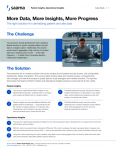Is it time to start rethinking mobile clinical trial apps?

Applications used in clinical trials can be extremely useful in recruitment, patient engagement, and more. However, it’s possible that the technology could use a makeover to reach its full potential.
To learn more, Outsourcing-Pharma connected with Clay Williams, vice president of mobile applications with Greenphire, a company that offers various financial management services for clinical trial patients.
OSP: Could you please talk about the evolution of apps and their use in clinical trials?
CW: One of the first technologies used by trial participants was an electronic diary (eDiary) which is used to collect electronic patient-reported outcomes (ePRO) data. These were the status quo until a few years ago.
In 2015, Apple released ResearchKit, an open-source framework for building research apps on the iPhone that offered several participant-friendly advances. A year later, ResearchStack was released, an open-source framework that offered similar capabilities on Android devices. These frameworks greatly raised awareness of the potential of mobile devices in clinical research, including the use of mobile to support virtual, decentralized, and hybrid studies.
Next, the COVID-19 pandemic significantly increased the financial and operational imperative for sponsors to invest in participant-focused apps. Such apps offer a huge benefit to both sites and participants but need to be approached properly and have a purposeful design.
OSP: What areas of clinical trials have apps tended to be more useful/appropriate?
CW: There are several situations where apps can enhance the experience of participating in a clinical trial, while also giving sites valuable information. The most obvious candidates are trials that require participants to keep track of something on a regular basis, such as symptoms or side effects. A well-designed app can help participants share such information in real time, reducing their burden while resulting in clearer, more accurate data.
Apps can also be helpful to keep participants informed and comfortable with the information provided in the app. There has traditionally been a deeper focus on collecting data from the participant with an app, and there is a great benefit that can be realized by offering information to the participant. This can include information about clinical trials in general, their specific trial, as well as situational updates (such as what is happening during a given phase of the pandemic). These sources of information can greatly reduce the anxiety common to trial participation.
When considering pairing an app with a trial, sponsors should start with this question - what will participants get out of it? Sponsors and sites also need to be very clear on what successful engagement with an app in a trial looks like.
The last thing participants want is to be reminded repeatedly to engage with an app. The goal isn’t engagement with the app but using the app to catalyze sufficient engagement with the trial to ensure protocol adherence. Apps should be developed to make it quick and simple for participants to log on, share their data or find essential information, and then move on with their day.
OSP: Then, how has the use of apps changed since the arrival of the pandemic and the rise of DCTs?
CW: The pandemic didn’t change the trajectory of trial technology, but it definitely accelerated the adoption of tech along that trajectory. In the earliest days of COVID-19, sponsors and sites had to make very difficult decisions about continuing or pausing trials, and in some cases, the availability of suitable technology was a factor in that decision process. The power of technology became clear as a result of the pandemic, but like many forcing functions, the need also meant that some tech was developed very quickly and wasn’t designed in a participant-centered manner. Participant-centered capabilities must be the starting point for creating an engaging app, followed by careful strategies to create study content that makes the best use of the app capabilities.
OSP: Which types of patients might apps leave out, or at least prove more challenging for?
CW: There are digital divides in participant-facing health technology, but the lines are complex. For example, people often assume that the older generation might be left out due to technological literacy, but they have actually adopted mobile technology in significant numbers (especially tablets.)
Ensuring equity requires that mobile app providers design technology with the awareness that not every potential participant will have the latest device or an unlimited data plan. A successful app strategy ensures parity on all major platforms (Android, iOS, and the web), minimizes device power and data usage, and considers tech and health literacy when creating participant-facing capabilities and content.
OSP: Considering recent developments, do you think clinical trial apps need to be drastically changed, or abandoned altogether? Please elaborate.
CW: Apps certainly should not be abandoned! But they need to be thought of very differently than they are today. You’ll often see apps lumped into what I call one of the “e” classes (eConsent, ePRO, eCOA, etc.) but they have so much more potential than that. They can be a huge asset to participants during their whole trial journey, while offering significant insight to sites, CROs, and sponsors.
Sponsors and sites should aspire to offer participants a digital companion that supports all parts of the trial, from identifying and enrolling in a trial, accessing relevant and helpful resources, recording information in real-time, having a view into site visits and/or travel itineraries, receiving reminders, and providing an easy way to track and manage reimbursements and/or stipends.
OSP: What can companies like yours do to improve apps, or improve the ways they’re used in clinical research?
CW: I’ve talked a lot about participant-centricity, but the other key stakeholder in the successful use of participant-facing tech in a trial are sites. It is essential that technology helps remove burdens from sites. Technology is proliferating in all parts of healthcare, including clinical trials, and the last thing we want to do is to add another system that requires a lot of ongoing care and feeding. We work hard to develop systems that offer automation wherever possible, requiring less effort from site staff and enabling them to focus their attention on participants.
OSP: Do you have anything to add?
CW: The next-generation participant experience in clinical trials should be focused on providing the utmost in support, flexibility, and convenience. This doesn’t just mean offering an app. This means understanding the participant and structuring the clinical trial around their journey, beginning with protocol design. With this approach, pharmaceutical companies, research sites, and solution providers can work together to offer apps that simplify and unify the participant’s trial activities, resulting in a less burdensome experience for both the participant and the sites supporting them.



















